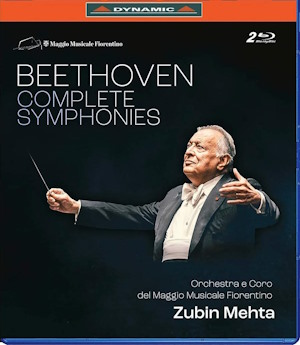
Ludwig van Beethoven (1770-1827)
Symphonies 1-9
Mandy Fredrich (soprano); Marie-Claude Chappius (mezzo-soprano); AJ Glueckert (tenor); Tareq Nazmi (bass)
Orchestra e Coro del Maggio Musicale Fiorentino/Zubin Mehta
rec. live, September-October 2021 & September 2022, Teatro del Maggio Musicale Fiorentino, Italy
Dynamic 57950 Blu-ray [2 discs: 395]
I must confess that I have never been a great fan of the Indian conductor Zubin Mehta; however, his Valencia Wagner Ring Cycle is one of my favourites on Blu-ray. His repertoire is among the most varied of any conductor, embracing diverse forms from the baroque to the avant-garde. His interpretations of music by Messiaen and Schoenberg are paradigms for younger conductors, and his ability to achieve the highest performances from different ensembles is legendary. This is witnessed by his music directorships of numerous major orchestras over the years.
Like Daniel Barenboim, Mehta is a great admirer of Furtwangler, and this influence comes through in these enlightening video recordings of the Beethoven symphonies. Recorded when he was in his late eighties, they reveal a great Beethoven conductor, rather like a vintage wine after decades of maturation. He recorded this cycle after developing his interpretations and readings through decades of study; his Ninth symphony with the New York Philharmonic is acclaimed, and his accompaniment in two piano concerto cycles are among the finest, so this collection should be obligatory for all devotees of the conductor.
These recordings were made at public concerts in 2021 and 2022 following the pandemic. It is clear that social distancing was in force, and most of the audience wear masks, although only a few musicians do so, but in the filming of the Eighth and Ninth symphonies, we can see that conditions are almost normal. One issue that stands out is Mehta’s poor health in the later concerts, yet despite his weak physical condition, he is at the top of his game, seated before his musicians and fully engaged in directing his musicians.
Historically informed performance practice is ignored here; repeats are observed and these performances take one back to the 1960s, yet are enriched with the superior technical skills of today. The interpretations are similar to those of Furtwängler or Klemperer because Mehta adopts a slow tempo, making some readings among the longest available. This is clearest in the opening two symphonies, in which the playing is magnificent, and blessed with consistently peerless expression by the orchestra.
Mehta’s beat throughout is precise and there are no dramatically exaggerated gestures; he presents a freshness in approach as if he is discovering this music for the first time. The strings are remarkable for their unity of playing and achieve a beautifully honed sound quality, evident in the bowing of the violins. The brass is wonderful and the woodwind’s intonation is astonishing – as good as any of the great world orchestras.
It is clear that the Orchestra del Maggio Fiorentino possesses musicians of the highest standard, which is especially noticeable in the woodwind; the oboist, clarinettist and bassoonist are excellent and the strength in depth of the orchestra is evident in that for some performances they are changed for other members of the company. The strings’ playing is gloriously rich and graceful and it becomes clear that rather than forcing the tempo, Mehta prefers to allow the full expressiveness of Beethoven’s music to be heard. While this style is unconventional today, listening to these performances allows more attention to be paid to the playing and sometimes to indulge in the beauty of Beethoven’s scores as they were played during most of the last century. At first, I did not take to the performance of all the repeats, but as Mehta coaxes marvellous playing from his musicians, I slowly came round to his interpretations.
In symphonies 1, 2 and 4, Mehta uses a score but dispenses with it in the other symphonies. He uses a baton while gently coaxing his musicians with his right hand. The video coverage allows us to see how he uses his facial movements and eye contact to guide the orchestra; sometimes a smile crosses his face in pleasure at a beautifully expressed phrase, or a grimace at one of the more tense and dramatic moments in the music. The harmony and respect – indeed awe – between the players and Mehta is palpable.
The singers in the Ninth were unknown to me, however, they provide wonderfully truthful and inspiring singing, and are matched by the outstanding forces of the chorus who surround the orchestra on the left and right of the stage.
The video direction by Tiziano Mancini employs as many as six cameras, adopting the usual views of the stage and allowing long and short-range shots of the orchestra with appropriate close-ups of solos by the musicians. The engineering by Claudio Speranzini and Antonio Martino is excellent, offering great clarity both visually and aurally. The Blu-ray discs come with a 16-page booklet of English and Italian texts by Danilo Prefumo on the symphonies, enhanced by colour photos of the orchestra, soloists and the conductor. This can be recommended as an inexpensive Christmas gift, especially to admirers of this great conductor.
Gregor Tassie
Help us financially by purchasing from


Technical details
PCM Stereo 2.0/DTS-HD Master Audio 5.1 – 1080i60 – 2BD 50 16:9


















